brakes YAMAHA YFM600FWA 2001 Notices Demploi (in French)
[x] Cancel search | Manufacturer: YAMAHA, Model Year: 2001, Model line: YFM600FWA, Model: YAMAHA YFM600FWA 2001Pages: 372, PDF Size: 10.01 MB
Page 14 of 372

EBU00015
CONTENTS
LOCATION OF THE WARNING AND
SPECIFICATION LABELS ....................... 1-1
SAFETY INFORMATION ........................ 2-1
DESCRIPTION AND MACHINE
IDENTIFICATION .................................... 3-1
Identification number records ........... 3-3
Key identification number ................. 3-5
Vehicle identification number ........... 3-5
Model label ......................................... 3-7
CONTROL FUNCTIONS ......................... 4-1
Main switch......................................... 4-1
Indicator lights .................................... 4-3
Oil temperature warning light
checking method .............................. 4-5
Speedometer .................................... 4-11
Fuel gauge ........................................ 4-11
Handlebar switches .......................... 4-13
Throttle lever .................................... 4-19
Speed limiter .................................... 4-21
Front brake lever .............................. 4-23Rear brake pedal and lever.............. 4-25
Parking brake .................................... 4-27
Drive select lever .............................. 4-29
Recoil starter..................................... 4-29
Fuel tank cap..................................... 4-31
Fuel cock ........................................... 4-33
Starter (choke) “ ” ........................ 4-35
Seat ................................................... 4-37
Storage box ...................................... 4-39
Front carrier ...................................... 4-39
Rear carrier ....................................... 4-39
Rear shock absorber
adjustment...................................... 4-41
Auxiliary DC connector .................... 4-43
PRE-OPERATION CHECKS .................... 5-1
Front and rear brakes......................... 5-7
Fuel .................................................... 5-11
Engine oil .......................................... 5-15
Final gear oil/Differential
gear oil ............................................ 5-19
Throttle lever .................................... 5-19
Fittings and Fasteners...................... 5-21
Lights................................................. 5-211
2
3
4
5
Page 44 of 372

2-11
●Always check for obstacles before operat-
ing in a new area.
Never attempt to operate over large obsta-
cles, such as large rocks or fallen trees. Al-
ways follow proper procedures when
operating over obstacles as described in
this manual.
●Always be careful when skidding or sliding.
Learn to safely control skidding or sliding
by practicing at low speeds and on level,
smooth terrain. On extremely slippery sur-
faces, such as ice, go slowly and be very
cautious in order to reduce the chance of
skidding or sliding out of control.
●Never operate an ATV in fast flowing water
or in water deeper than that recommended
in this manual. Remember that wet brakes
may have reduced stopping ability. Test
your brakes after leaving water. If neces-
sary, apply them several times to let friction
dry out the linings.
Page 86 of 372
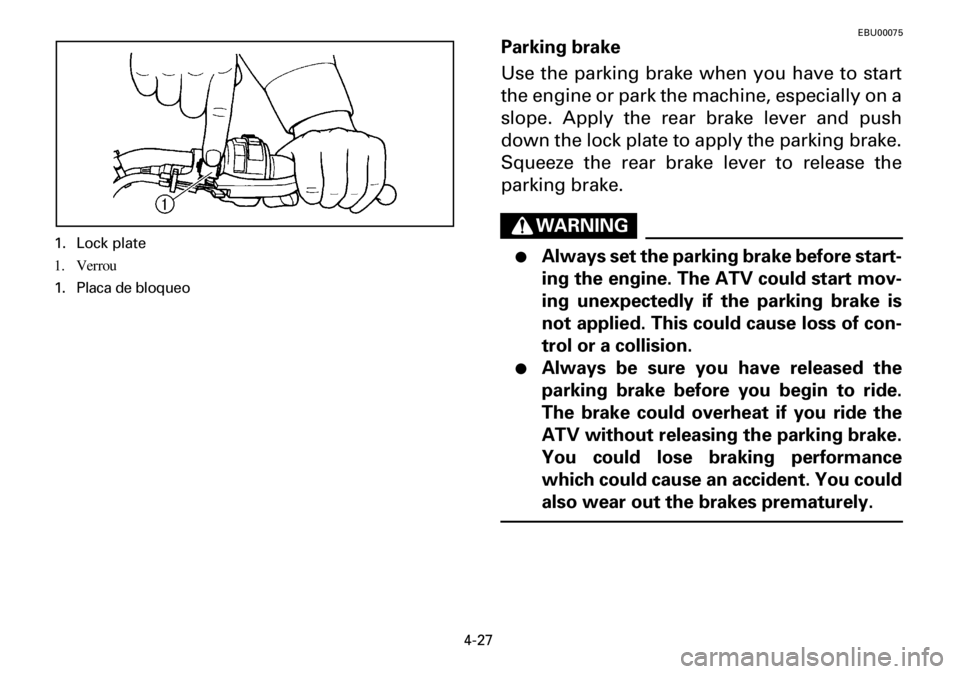
4-27
EBU00075
Parking brake
Use the parking brake when you have to start
the engine or park the machine, especially on a
slope. Apply the rear brake lever and push
down the lock plate to apply the parking brake.
Squeeze the rear brake lever to release the
parking brake.
WARNING
●Always set the parking brake before start-
ing the engine. The ATV could start mov-
ing unexpectedly if the parking brake is
not applied. This could cause loss of con-
trol or a collision.
●Always be sure you have released the
parking brake before you begin to ride.
The brake could overheat if you ride the
ATV without releasing the parking brake.
You could lose braking performance
which could cause an accident. You could
also wear out the brakes prematurely.
1. Lock plate
1. Verrou
1. Placa de bloqueo
Page 118 of 372
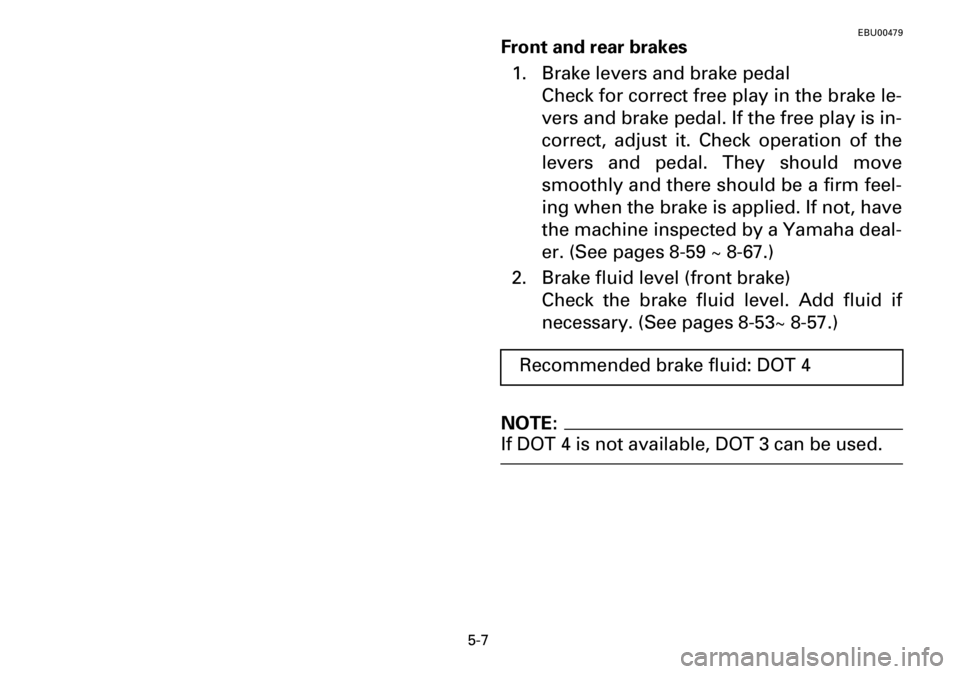
5-7
EBU00479
Front and rear brakes
1. Brake levers and brake pedal
Check for correct free play in the brake le-
vers and brake pedal. If the free play is in-
correct, adjust it. Check operation of the
levers and pedal. They should move
smoothly and there should be a firm feel-
ing when the brake is applied. If not, have
the machine inspected by a Yamaha deal-
er. (See pages 8-59 ~ 8-67.)
2. Brake fluid level (front brake)
Check the brake fluid level. Add fluid if
necessary. (See pages 8-53~ 8-57.)
NOTE:
If DOT 4 is not available, DOT 3 can be used.Recommended brake fluid: DOT 4
Page 120 of 372

5-9
3. Brake fluid leakage
Check to see if any brake fluid is leaking
out of the hose, joint or master cylinder of
the front brake. Apply the brake firmly for
one minute. If the lever moves slowly in-
ward, there may be a leak in the brake sys-
tem. If there is any leakage, the brake
system should be inspected by a Yamaha
dealer.
4. Brake operation
Test the brakes at slow speed after start-
ing out to make sure they are working
properly. If the brakes do not provide
proper braking performance, inspect the
brakes for wear. (See page 8-51.)
WARNING
Always check the brakes at the start of every
ride. Do not ride the ATV if you find any prob-
lem with the brakes or you could lose braking
ability, which could lead to an accident. If a
problem cannot be corrected by the adjust-
ment procedures provided in this manual,
have the ATV inspected by a Yamaha dealer.
Page 152 of 372
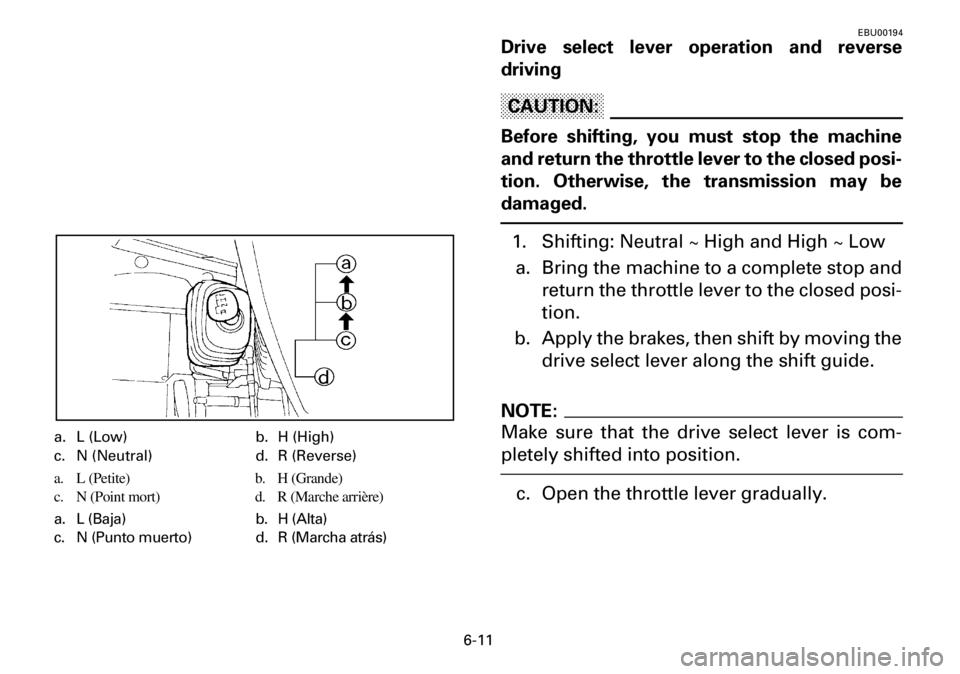
6-11
EBU00194
Drive select lever operation and reverse
driving
CAUTION:
Before shifting, you must stop the machine
and return the throttle lever to the closed posi-
tion. Otherwise, the transmission may be
damaged.
1. Shifting: Neutral ~ High and High ~ Low
a. Bring the machine to a complete stop and
return the throttle lever to the closed posi-
tion.
b. Apply the brakes, then shift by moving the
drive select lever along the shift guide.
NOTE:
Make sure that the drive select lever is com-
pletely shifted into position.
c. Open the throttle lever gradually.
a. L (Low) b. H (High)
c. N (Neutral) d. R (Reverse)
a. L (Petite) b. H (Grande)
c. N (Point mort) d. R (Marche arrière)
a. L (Baja) b. H (Alta)
c. N (Punto muerto) d. R (Marcha atrás)
Page 162 of 372
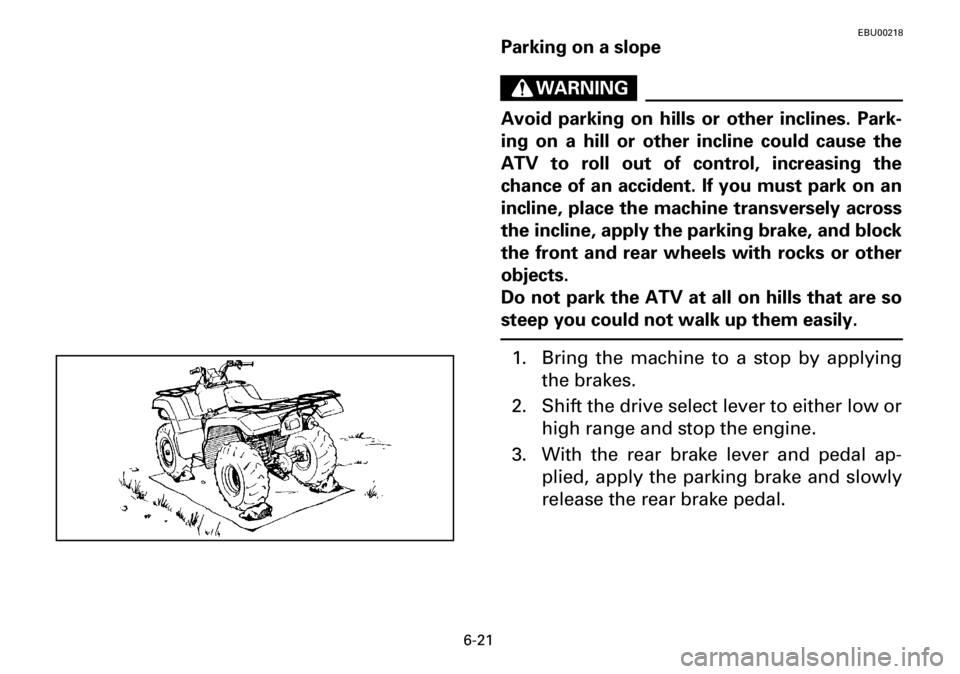
6-21
EBU00218
Parking on a slope
WARNING
Avoid parking on hills or other inclines. Park-
ing on a hill or other incline could cause the
ATV to roll out of control, increasing the
chance of an accident. If you must park on an
incline, place the machine transversely across
the incline, apply the parking brake, and block
the front and rear wheels with rocks or other
objects.
Do not park the ATV at all on hills that are so
steep you could not walk up them easily.
1. Bring the machine to a stop by applying
the brakes.
2. Shift the drive select lever to either low or
high range and stop the engine.
3. With the rear brake lever and pedal ap-
plied, apply the parking brake and slowly
release the rear brake pedal.
Page 208 of 372

7-35
Select a large, flat area off-road to become fa-
miliar with your ATV. Make sure that this area
is free of obstacles and other riders. You
should practice control of the throttle, brakes,
shifting procedures, and turning techniques in
this area before trying more difficult terrain. Al-
ways avoid riding on paved surfaces: the ATV
is designed for off-road use only, and handling
maneuvers are more difficult to perform on
pavement.
Set the parking brake and follow the instruc-
tion on page 6-3 to start the engine. Once it has
warmed up you are ready to begin riding your
ATV. As you get on the ATV, be sure not to ac-
cidentally move the shift pedal. Remember
that the engine and exhaust pipe will be hot
when riding and afterwards; do not allow skin
or clothing to come in contact with these com-
ponents.
Page 210 of 372
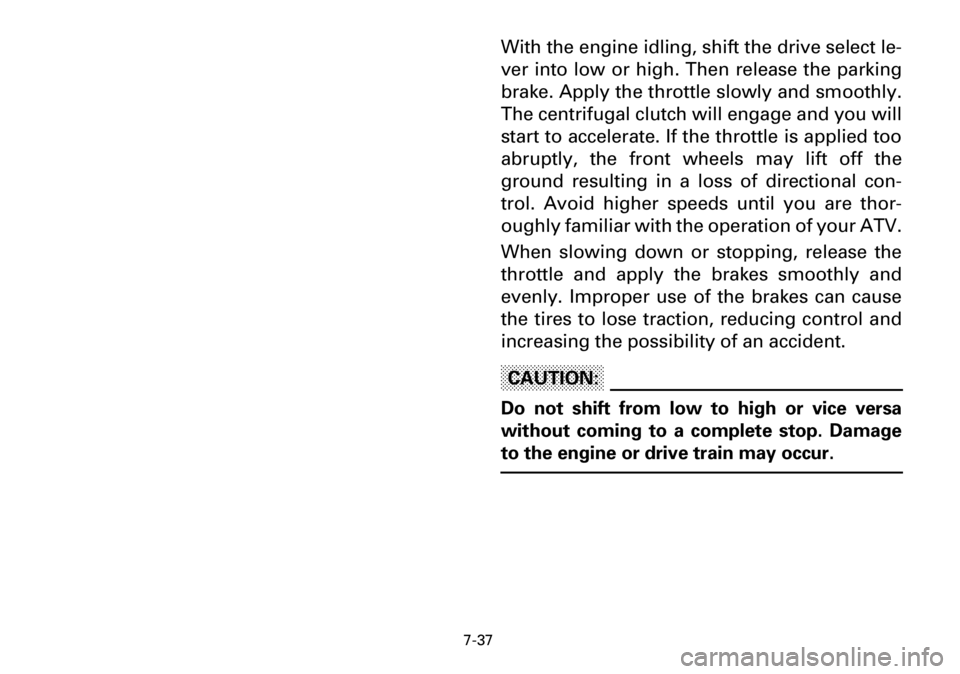
7-37
With the engine idling, shift the drive select le-
ver into low or high. Then release the parking
brake. Apply the throttle slowly and smoothly.
The centrifugal clutch will engage and you will
start to accelerate. If the throttle is applied too
abruptly, the front wheels may lift off the
ground resulting in a loss of directional con-
trol. Avoid higher speeds until you are thor-
oughly familiar with the operation of your ATV.
When slowing down or stopping, release the
throttle and apply the brakes smoothly and
evenly. Improper use of the brakes can cause
the tires to lose traction, reducing control and
increasing the possibility of an accident.
CAUTION:
Do not shift from low to high or vice versa
without coming to a complete stop. Damage
to the engine or drive train may occur.
Page 224 of 372

7-51
If your ATV has stalled or stopped and you be-
lieve you can continue up the hill, restart care-
fully to make sure you do not lift the front
wheels which could cause you to lose control.
If you are unable to continue up the hill, dis-
mount the ATV on the uphill side. Physically
turn the ATV around and then descend the hill.
If you start to roll backwards, DO NOT apply ei-
ther brake abruptly. If you are in 2WD, apply
only the front brake. When this ATV is in 4WD,
all wheels (front and rear) are interconnected
by the drive train. This means that applying ei-
ther the front brake or the rear brake will brake
all wheels. When descending hills, using either
brake lever or the brake pedal will brake the
wheels on the downhill side. Avoid sudden ap-
plication of either the front or rear brake be-
cause the wheels on the uphill side could come
off the ground. The ATV could easily tip over
backwards. Apply both the front and rear
brakes gradually, or dismount the ATV imme-
di-ately on the uphill side.